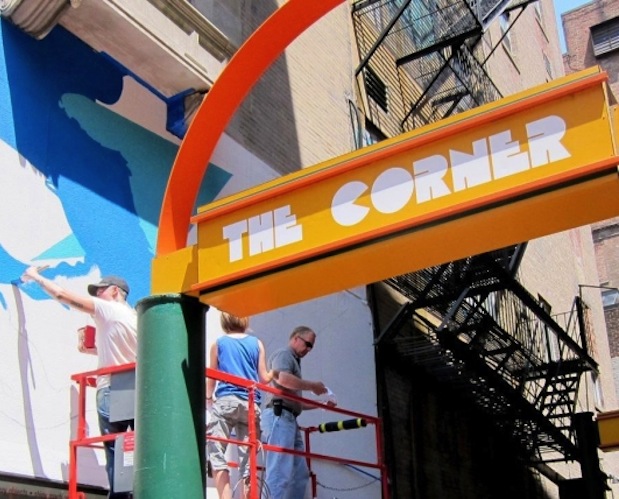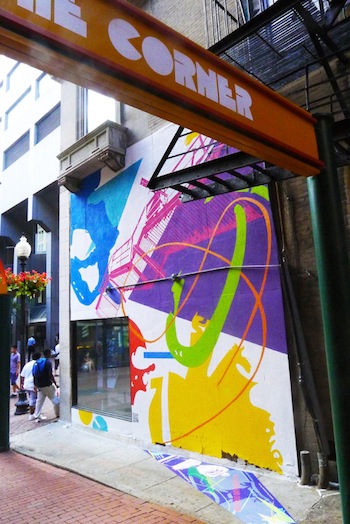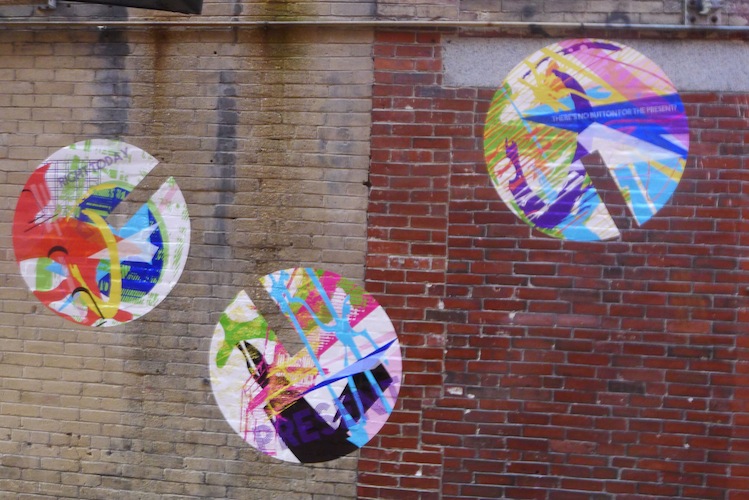Visual Art Review: “Color Crossing” — An Urban Art Intervention in Downtown Boston
With Color Crossing, Kate Gilbert wanted to showcase “the collision between sights and sounds that make Downtown Crossing so vibrant.”
Color Crossing: An Interactive Visual/Audio Temporary Urban Art Intervention, by Kate Gilbert

Workers installing the Color Crossing mural onto the wall of 17 Winter St., at The Corner Mall’s Music Hall Place, in late July 2014. Photo: Kate Gilbert.
By Mark Favermann
Simply put, public art is art in any media that has been planned and executed with the intention of being staged in the public realm. It is usually outside, though sometimes inside, but it is always free and accessible to all. Public art is site specific, often draws on community involvement, and can be collaborative as well as interactive. The relationship between the content and the audience – what the artwork is saying and to whom — is an important facet of its overall success.
These artworks often make use of a range of approaches that can be mixed and matched: sculpture, found objects, conceptual art, digital art, projections, interventions, performance pieces, storytelling, sound and light projects, dance and spoken word. Public art is not simply about creating an artwork, but about involving creativity in the same developmental process as any other civic design project. This procedure includes, after securing the all-important project funding, working with and through government agencies, receiving corporate or institutional approvals, obtaining engineering authorization, and adhering to safety requirements.
And this is what artist Kate Gilbert does.
She began as an abstract painter. But today, Gilbert is a site-specific public artist. Trained at both Connecticut College and the the Museum of Fine Arts School, she understands that studio work does not easily translate into effective civic statements, so her work evolves out of working closely with the public space. Generally attracted to temporary installations, Gilbert likes to create spaces that cultivate a thoughtful reaction. In fact, the more contemplative the better. Kate takes an area and ‘activates’ it for the sake of provoking thought. Activity, color, sound, action are integrated into her work. She wants her pieces to generate ideas and complex reactions. Interactive is not just a descriptive word for her art; it is an essential prerequisite. She strives to achieve a dialogue with and about public space.
For her recent piece, Color Crossing, Gilbert decided to create an interactive work in an alleyway at Downtown Crossing in Boston’s traditional commercial and financial core. Located at The Corner, a 35 year-old food court on the corner of Winter and Washington Streets, the mural was completed in late July 2014. The Downtown Boston Business Improvement District (BID) sponsored the project on the walls and sidewalk of Music Hall Place, the alleyway entrance to the Corner Mall Food Court, which is located between 15 Winter Street and 17 Winter Street. The Project partners with TBID were 3MJ Realty (17 Winter St.) and The Druker Company (15 Winter St., The Corner Mall).
Color Crossing is part of BID’s public art program “Pause,” which is dedicated to commissioning public art that encourages people to take a moment to appreciate the liveliness, beauty, and history of the Downtown district. This project is the first of an initiative to bring public art to 25 alleys and other spaces within the downtown Boston area.
Color Crossing is a visual/audio representation of the layers of history in Boston’s Downtown Crossing as well as the diversity of people who frequent the area. Gilbert says that she wanted to showcase “the collision between sights and sounds that make Downtown Crossing so vibrant.” The work is both an urban art intervention and a piece of public storytelling, made up of vibrant color, bold graphics, and an audio composition that includes on-site interviews and original music. Excerpts have been taken from interviews and mixed with music. The sound portion plays continuously in the alley from 7 a.m. to 7 p.m.
The temporal artwork (it is slated to be removed in October) has been created by Gilbert to tell a story, a word/sound/visual narrative experience generated by the thoughts, history, and hopes of a diverse group of passer-bys. Over a number of months, Gilbert interviewed hundreds of pedestrians walking through and by the alleyway. Individuals granted her permission to be recorded during these onsite interviews. Working amidst the noise and activity of gritty Downtown Boston (and forced to become a bit of a sound engineer in the process), Gilbert faced a number of challenges. Few were more irritating than the drone of a grease trap fan at the nearby food court.
Gilbert spoke to older retired residents, working individuals, the homeless and tourists. There is a great diversity of voices in the presentation, though, interestingly enough, she says few if any white individuals stopped to be interviewed. In a way, she performed a valuable social/psychological survey. She asked people to dream that they had a time machine. If they could change the past or the future what would they do? What would be different? What buttons would be pushed?
To some, this conversation invited ideas about sharing with others, even serving a therapeutic function. In the sometimes freezing cold, she interviewed people about their hopes, dreams, personal history, and future wishes. Some of the more poignant responses: “I wish I hadn’t started to drink in the 4th grade”; “How difficult was my mother’s cancer,” and “I would like to see how my grandchildren turn out in the future.”
After listening to the recorded testimonials, the artist interpreted the material and came up with a compelling visual statement (a reflection on what she heard) by applying large swaths of vibrant color to the ground and walls of the alleyway. She used sharp diagonals to underscore and suggest dimension and space. The complimentary audio component — field recordings, on-site interviews, and original music — was created by sound artist Halsey Burgund.
Situated in an already strongly branded urban space, Color Crossing is made to be transitory. Everything that the work is made of had to be environmentally reversible and removable. Green is not just a color, but a standard practice in many cities today. Still, despite this impression of ephemerality, the best of temporary public art pieces — like Color Crossing — leave lasting impressions.
An urban designer, Mark Favermann has been deeply involved in branding, enhancing, and making more accessible parts of cities, sports venues, and key institutions. Also an award-winning public artist, he creates functional public art as civic design. Mark created the Looks of the 1996 Centennial Olympic Games in Atlanta, the 1999 Ryder Cup Matches in Brookline, MA, and the 2000 NCAA Final Four in Indianapolis. The designer of the renovated Coolidge Corner Theatre, he has been a design consultant to the Red Sox since 2002.
Tagged: Color Crossing, Downtown Crossing Boston, Kate Gilbert, Mark Favermann


